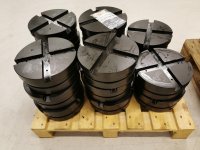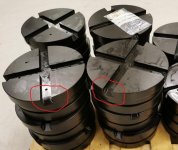Hi,
I'm making a series of turned parts that have a patterned chamfered feature.
Due to the fact that I've only got straight axial and radial live tool holders; milling this chamfer essentially becomes a little elegant and time consuming operation with a million step-downs to get a relatively smooth surface. I've been looking a bit on a few adjustable angle live tool holders, but I'm weary of stepping down to an ER20 or ER16 size collet. It would however obviously reduce my machining time drastically and improve the surface finish.
Anyone here with experience using these adjustable holders? Haven't got a quote yet - I presume they cost an arm and a leg. Any manufacturer recommendations would be most welcome as well.
I've got a Haas ST-30Y with a BMT65 turret.
Thanks again!
PS: Making sensible adaptive milling tool paths in "Inventor CAM" really is doing my head in. Will probably have a rant about that in the CAM section.
I'm making a series of turned parts that have a patterned chamfered feature.
Due to the fact that I've only got straight axial and radial live tool holders; milling this chamfer essentially becomes a little elegant and time consuming operation with a million step-downs to get a relatively smooth surface. I've been looking a bit on a few adjustable angle live tool holders, but I'm weary of stepping down to an ER20 or ER16 size collet. It would however obviously reduce my machining time drastically and improve the surface finish.
Anyone here with experience using these adjustable holders? Haven't got a quote yet - I presume they cost an arm and a leg. Any manufacturer recommendations would be most welcome as well.
I've got a Haas ST-30Y with a BMT65 turret.
Thanks again!
PS: Making sensible adaptive milling tool paths in "Inventor CAM" really is doing my head in. Will probably have a rant about that in the CAM section.




